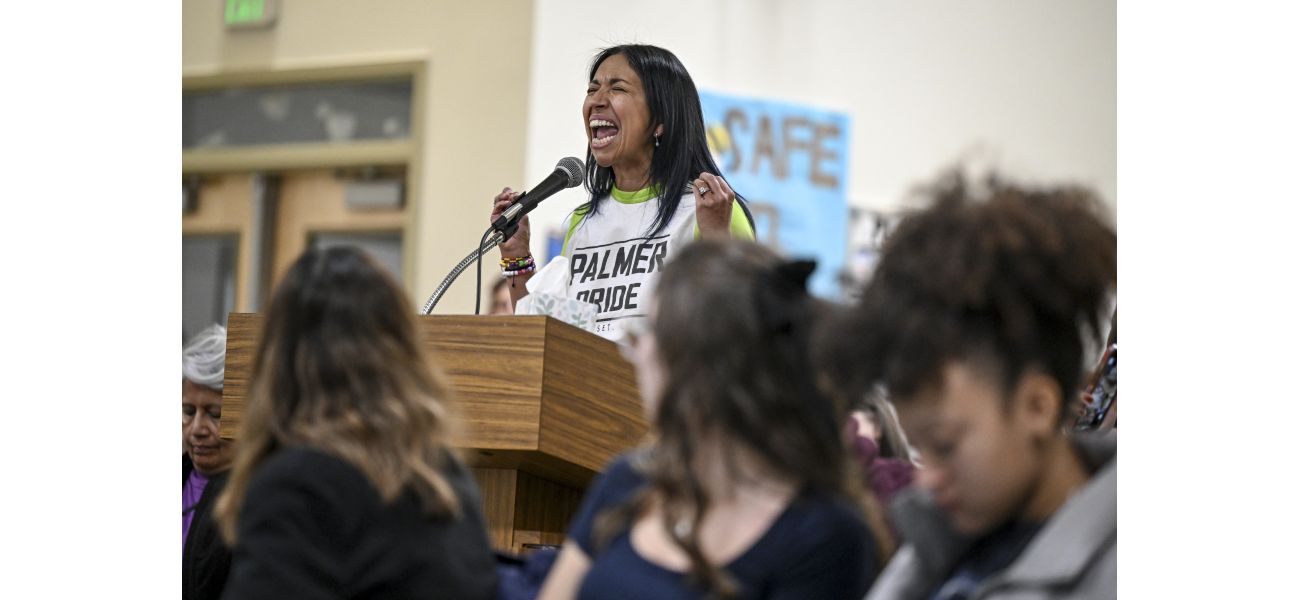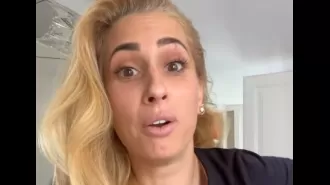Denver Public Schools is making changes to address declining enrollment, including closing seven schools and reducing the number of grades at three others.
Board President Carrie Olson stated that our goal is to maintain the district's financial stability and the closures will help us use our resources more effectively.
November 22nd 2024.

Denver Public Schools is making some significant changes at the end of the current academic year. In order to avoid a financial crisis, the district has decided to close seven schools and reduce the number of grades served at three others. This decision comes as enrollment numbers continue to decrease throughout the state of Colorado.
The Board of Education unanimously voted to approve Superintendent Alex Marrero's consolidation plan, which was announced two weeks ago. While the superintendent only needed the board's approval to close schools, his plan to restructure the remaining schools hinged on this decision.
Board President Carrie Olson emphasized the importance of ensuring the district's financial sustainability before the vote. She stated that the closures would allow for more efficient allocation of resources. Last academic year, over 88,000 students were enrolled in DPS schools, but this number has dropped by 4% since the district's peak enrollment five years ago. As a result, DPS has lost millions of dollars in per-pupil funding from the state.
With the board's approval, five elementary schools – Castro, Columbian, Palmer, Schmitt, and the International Academy of Denver at Harrington – will be closed, along with West Middle School and the Denver School of Innovation and Sustainable Design, a high school. Additionally, three schools – DCIS Baker 6-12, Dora Moore ECE-8 School, and Kunsmiller Creative Arts Academy – will be restructured to serve fewer grades and therefore, fewer students.
These changes will affect a total of 1,844 students and 267 staff members. Many of the schools on the closure list have a high enrollment of students of color and students from lower-income families who qualify for free or reduced-cost lunches. However, district officials have reassured staff members at these schools that they will have the opportunity to interview for other positions within DPS.
During Thursday's meeting, Superintendent Marrero stressed that the district was not only listening but also hearing the concerns and opinions of students, staff, and community members. He acknowledged the impact that their comments and stories had on the decision-making process.
This decision by the seven-member board marks a reversal of their stance from two years ago when presented with a similar proposal. At that time, a majority of board members were hesitant to close schools, as DPS has a history of closing schools due to poor academic performance. However, in the past two years, it has become increasingly apparent that school closures are necessary due to declining enrollment.
Unlike two years ago, board members did not debate whether DPS should close schools. Instead, each member read a prepared statement before voting. It was evident that this was a difficult decision for many board members, with some, like Xóchitl “Sochi” Gaytán, becoming emotional while reading their statements.
Despite the emotional difficulty of the decision, board members ultimately prioritized the well-being of students and the need for them to attend schools with adequate resources. As board member Scott Esserman put it, "We're looking at a situation where there isn't a right or best answer. What we do and say tonight speaks to our future and our investment in resources for people who are destined for greatness."
After the board's vote, some audience members expressed their disapproval by shouting "Shame on you!" before being escorted out by DPS employees and security. It should be noted that the board ultimately decided to close three schools, which is significantly less than the initial proposal of ten schools by Superintendent Marrero.
The closures and changes to these ten schools will take effect after the 2024-25 academic year. Marrero's plan heavily relies on school choice, giving parents and guardians a say in where their child attends school next year. DPS will also create or expand enrollment zones, which include multiple schools rather than just one neighborhood school.
Most of the elementary schools on the closure list will join a new or expanded enrollment zone, while DCIS Baker will also become part of an enrollment zone after its restructuring. Students from Castro Elementary will have the option to attend Knapp Elementary or CMS Community School. The district will guarantee students a seat at one of the schools in their new enrollment zone and provide transportation to their new school.
Students affected by the closures will have the highest priority when it comes to school choice in January. Spanish-speaking students will also receive bilingual services at other schools in their boundary or enrollment zone through the district's Transitional Native Language Instruction program. Additionally, preschool programs at closed schools will move to new locations, although details have not been provided yet.
The decision to close schools comes as K-12 enrollment in public schools continues to decline throughout the United States due to a decrease in the number of births. In Denver, this issue has been exacerbated by gentrification, which has driven up housing costs and made it too expensive for families to live in the area. While this decision was a difficult one for the board, they ultimately had to prioritize the financial stability and future success of the district.
Denver Public Schools has recently announced its decision to close seven schools and reduce the number of grades served at three other schools. This comes as a measure to prevent a financial crisis in the face of declining enrollment numbers across the state of Colorado. The Board of Education unanimously approved Superintendent Alex Marrero's consolidation plan, which was announced two weeks ago. While the superintendent only needed the board's approval to close schools, his plan to restructure other schools was contingent upon this decision.
Board President Carrie Olson emphasized the district's responsibility to ensure financial viability, stating that these closures will allow for more efficient allocation of resources. Last year, over 88,000 students were enrolled in DPS schools, but this number has seen a 4% drop from the district's peak enrollment five years ago. As a result, DPS has lost millions of dollars in per-pupil funding from the state.
Under the approved plan, five elementary schools - Castro, Columbian, Palmer, Schmitt, and the International Academy of Denver at Harrington - as well as West Middle School and the Denver School of Innovation and Sustainable Design, a high school, will be closed. Additionally, three schools - DCIS Baker 6-12, Dora Moore ECE-8 School, and Kunsmiller Creative Arts Academy - will be restructured to serve fewer grades and therefore, fewer students. These 10 schools currently enroll 1,844 students and have 267 staff members. Many of these schools have a high percentage of students of color and from lower-income families who qualify for free or reduced-cost lunches.
The district has stated that staff members from the closing schools will have the opportunity to interview for other positions within DPS. During the board meeting, Superintendent Marrero acknowledged the community's concerns and opposition to the closures, assuring them that their comments and stories had been heard and taken into consideration.
The decision to close these schools marks a change in the board's stance from two years ago when they were hesitant to close schools. However, it has become clear that these closures are necessary due to declining enrollment. Unlike two years ago, there was no debate among board members at the meeting, with each member reading a prepared statement before voting. It was evident that the decision to close schools was a difficult one for the board, with some members expressing their struggle and even becoming emotional.
The board members believe that these closures will ultimately benefit students by allowing them to attend schools with more resources. They also emphasized the district's duty to maintain financial stability. The closures and changes will take effect after the 2024-25 academic year, giving families time to adjust. Marrero's plan also includes measures such as school choice and enrollment zones to ensure that students have a say in where they will attend school.
After the closures, DPS will create or expand enrollment zones, which will contain multiple schools instead of just one neighborhood school. All but one of the elementary schools on the closure list will either join a new zone or an expanded one. Students at Castro Elementary will have the option to attend either Knapp Elementary or CMS Community School. The district has guaranteed that students will have a seat at one of the schools in their new enrollment zone and will provide transportation to their new school. Students affected by the closures will also receive priority in the school choice process.
For Spanish-speaking students, the district will ensure they have access to bilingual services at other schools in their zone. Preschool programs at the closing schools will also be relocated, but details have yet to be announced. The decision to close schools is a result of declining enrollment not just in Denver but across the country. Factors such as gentrification have contributed to this decline, making it difficult for families to afford to live in the area. The district's priority is to maintain financial stability while also providing quality education for its students.
The Board of Education unanimously voted to approve Superintendent Alex Marrero's consolidation plan, which was announced two weeks ago. While the superintendent only needed the board's approval to close schools, his plan to restructure the remaining schools hinged on this decision.
Board President Carrie Olson emphasized the importance of ensuring the district's financial sustainability before the vote. She stated that the closures would allow for more efficient allocation of resources. Last academic year, over 88,000 students were enrolled in DPS schools, but this number has dropped by 4% since the district's peak enrollment five years ago. As a result, DPS has lost millions of dollars in per-pupil funding from the state.
With the board's approval, five elementary schools – Castro, Columbian, Palmer, Schmitt, and the International Academy of Denver at Harrington – will be closed, along with West Middle School and the Denver School of Innovation and Sustainable Design, a high school. Additionally, three schools – DCIS Baker 6-12, Dora Moore ECE-8 School, and Kunsmiller Creative Arts Academy – will be restructured to serve fewer grades and therefore, fewer students.
These changes will affect a total of 1,844 students and 267 staff members. Many of the schools on the closure list have a high enrollment of students of color and students from lower-income families who qualify for free or reduced-cost lunches. However, district officials have reassured staff members at these schools that they will have the opportunity to interview for other positions within DPS.
During Thursday's meeting, Superintendent Marrero stressed that the district was not only listening but also hearing the concerns and opinions of students, staff, and community members. He acknowledged the impact that their comments and stories had on the decision-making process.
This decision by the seven-member board marks a reversal of their stance from two years ago when presented with a similar proposal. At that time, a majority of board members were hesitant to close schools, as DPS has a history of closing schools due to poor academic performance. However, in the past two years, it has become increasingly apparent that school closures are necessary due to declining enrollment.
Unlike two years ago, board members did not debate whether DPS should close schools. Instead, each member read a prepared statement before voting. It was evident that this was a difficult decision for many board members, with some, like Xóchitl “Sochi” Gaytán, becoming emotional while reading their statements.
Despite the emotional difficulty of the decision, board members ultimately prioritized the well-being of students and the need for them to attend schools with adequate resources. As board member Scott Esserman put it, "We're looking at a situation where there isn't a right or best answer. What we do and say tonight speaks to our future and our investment in resources for people who are destined for greatness."
After the board's vote, some audience members expressed their disapproval by shouting "Shame on you!" before being escorted out by DPS employees and security. It should be noted that the board ultimately decided to close three schools, which is significantly less than the initial proposal of ten schools by Superintendent Marrero.
The closures and changes to these ten schools will take effect after the 2024-25 academic year. Marrero's plan heavily relies on school choice, giving parents and guardians a say in where their child attends school next year. DPS will also create or expand enrollment zones, which include multiple schools rather than just one neighborhood school.
Most of the elementary schools on the closure list will join a new or expanded enrollment zone, while DCIS Baker will also become part of an enrollment zone after its restructuring. Students from Castro Elementary will have the option to attend Knapp Elementary or CMS Community School. The district will guarantee students a seat at one of the schools in their new enrollment zone and provide transportation to their new school.
Students affected by the closures will have the highest priority when it comes to school choice in January. Spanish-speaking students will also receive bilingual services at other schools in their boundary or enrollment zone through the district's Transitional Native Language Instruction program. Additionally, preschool programs at closed schools will move to new locations, although details have not been provided yet.
The decision to close schools comes as K-12 enrollment in public schools continues to decline throughout the United States due to a decrease in the number of births. In Denver, this issue has been exacerbated by gentrification, which has driven up housing costs and made it too expensive for families to live in the area. While this decision was a difficult one for the board, they ultimately had to prioritize the financial stability and future success of the district.
Denver Public Schools has recently announced its decision to close seven schools and reduce the number of grades served at three other schools. This comes as a measure to prevent a financial crisis in the face of declining enrollment numbers across the state of Colorado. The Board of Education unanimously approved Superintendent Alex Marrero's consolidation plan, which was announced two weeks ago. While the superintendent only needed the board's approval to close schools, his plan to restructure other schools was contingent upon this decision.
Board President Carrie Olson emphasized the district's responsibility to ensure financial viability, stating that these closures will allow for more efficient allocation of resources. Last year, over 88,000 students were enrolled in DPS schools, but this number has seen a 4% drop from the district's peak enrollment five years ago. As a result, DPS has lost millions of dollars in per-pupil funding from the state.
Under the approved plan, five elementary schools - Castro, Columbian, Palmer, Schmitt, and the International Academy of Denver at Harrington - as well as West Middle School and the Denver School of Innovation and Sustainable Design, a high school, will be closed. Additionally, three schools - DCIS Baker 6-12, Dora Moore ECE-8 School, and Kunsmiller Creative Arts Academy - will be restructured to serve fewer grades and therefore, fewer students. These 10 schools currently enroll 1,844 students and have 267 staff members. Many of these schools have a high percentage of students of color and from lower-income families who qualify for free or reduced-cost lunches.
The district has stated that staff members from the closing schools will have the opportunity to interview for other positions within DPS. During the board meeting, Superintendent Marrero acknowledged the community's concerns and opposition to the closures, assuring them that their comments and stories had been heard and taken into consideration.
The decision to close these schools marks a change in the board's stance from two years ago when they were hesitant to close schools. However, it has become clear that these closures are necessary due to declining enrollment. Unlike two years ago, there was no debate among board members at the meeting, with each member reading a prepared statement before voting. It was evident that the decision to close schools was a difficult one for the board, with some members expressing their struggle and even becoming emotional.
The board members believe that these closures will ultimately benefit students by allowing them to attend schools with more resources. They also emphasized the district's duty to maintain financial stability. The closures and changes will take effect after the 2024-25 academic year, giving families time to adjust. Marrero's plan also includes measures such as school choice and enrollment zones to ensure that students have a say in where they will attend school.
After the closures, DPS will create or expand enrollment zones, which will contain multiple schools instead of just one neighborhood school. All but one of the elementary schools on the closure list will either join a new zone or an expanded one. Students at Castro Elementary will have the option to attend either Knapp Elementary or CMS Community School. The district has guaranteed that students will have a seat at one of the schools in their new enrollment zone and will provide transportation to their new school. Students affected by the closures will also receive priority in the school choice process.
For Spanish-speaking students, the district will ensure they have access to bilingual services at other schools in their zone. Preschool programs at the closing schools will also be relocated, but details have yet to be announced. The decision to close schools is a result of declining enrollment not just in Denver but across the country. Factors such as gentrification have contributed to this decline, making it difficult for families to afford to live in the area. The district's priority is to maintain financial stability while also providing quality education for its students.
[This article has been trending online recently and has been generated with AI. Your feed is customized.]
[Generative AI is experimental.]
0
0
Submit Comment





